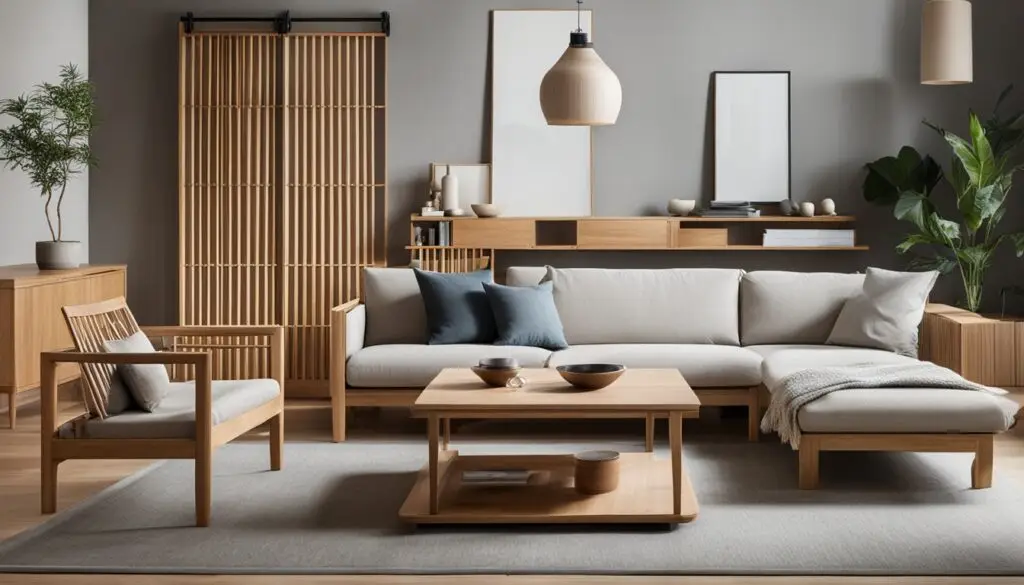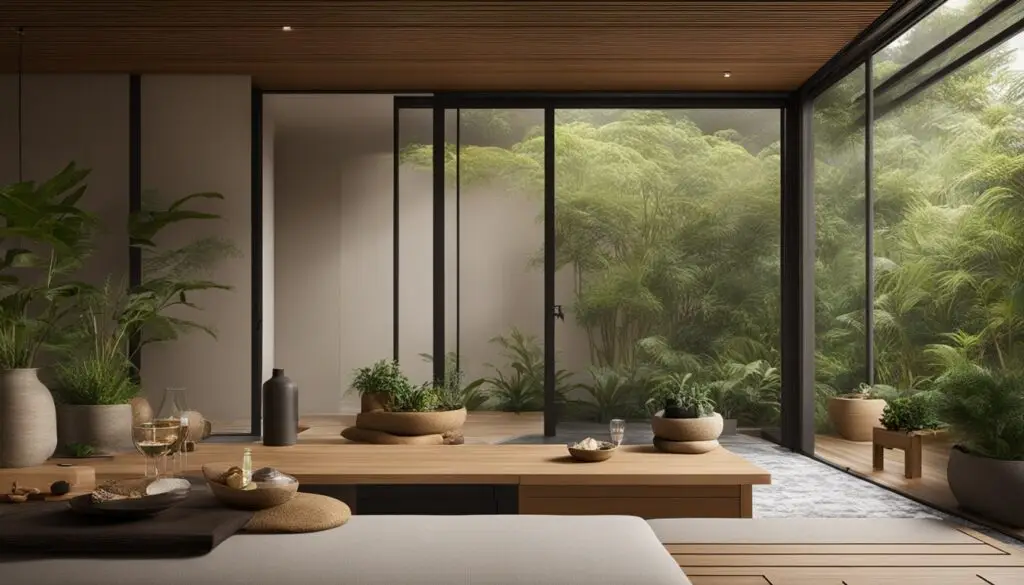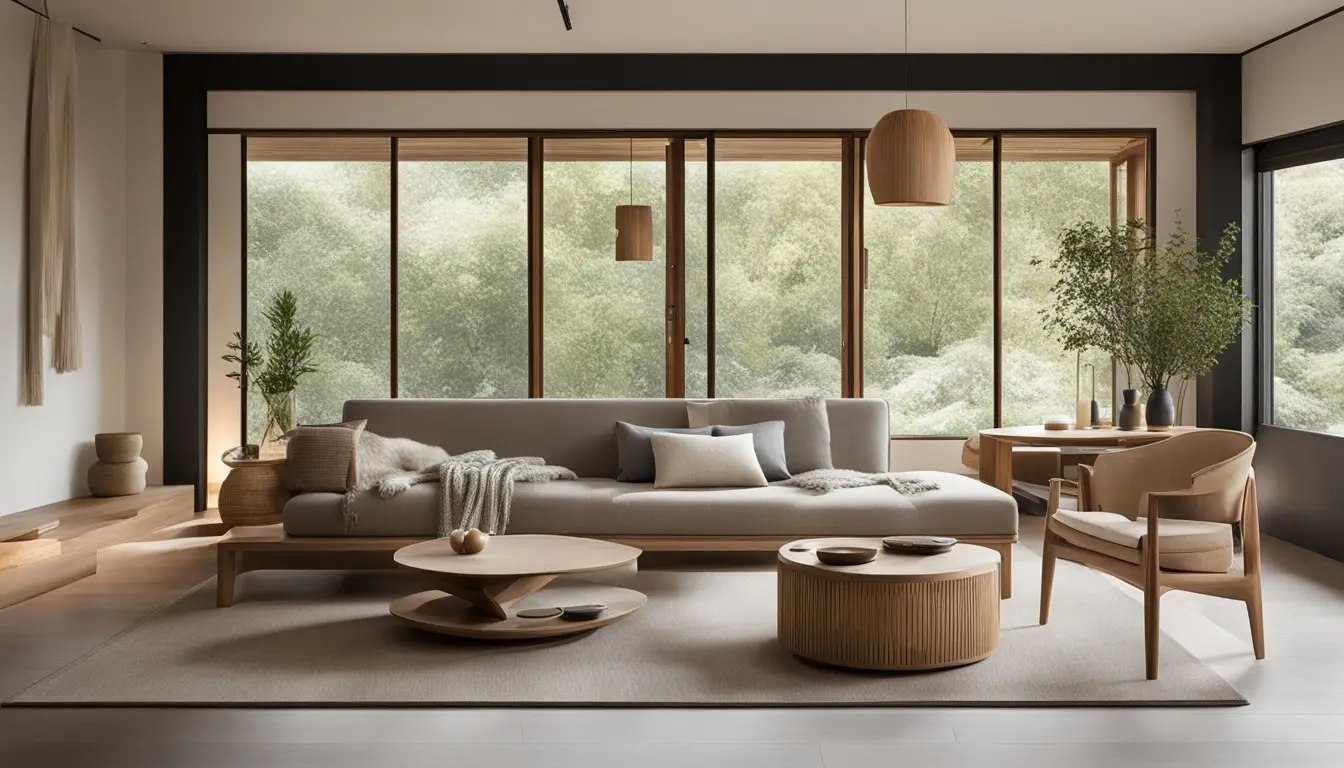Ever thought about mixing the calm of Japanese design with the coziness of Scandinavian style?
Japandi does just that. It’s a combination of scandinavian and japanese fusion. This trend adds peace and simplicity to homes, blending the two cultures perfectly. It uses elements that are simple yet useful. This mix includes high-quality stuff, soft colors, and a touch of old and new styles.
This mix is much more than looks. According to experts like Laila Rietbergen and Shanty Wijaya, Japandi is a way of life. It’s about finding joy in simple, natural things. This design takes the calmness of Japanese spaces and the warmth of Scandinavia’s Hygge to create inviting and inspiring areas.
Key Takeaways
- Japandi combines Japanese and Scandinavian interior design1.
- It’s all about calm, simple, and natural things.
- It loves using great materials and soft colors1.
- It’s a lifestyle choice celebrating the beauty of nature and easy living.
- It mixes Japanese Zen with Danish coziness to make cozy yet serene spaces1.
Introduction to Japandi Style
Japandi style is a cool mix of Japanese and Scandinavian design. People all over love it. It blends the minimal and functional parts of Scandinavian style with Japan’s elegant look23. Japandi pays close attention to using natural materials, soft colors, and simple, natural shapes.
The Essence of Japandi
Japandi decor mixes the best of East and West design ways. It puts together Japan’s love for imperfections and Scandinavian cozy vibes. They use earthy tones and dark shades to make things pop4. Also, Japandi loves using eco-friendly materials like wood and cotton. This shows they care about quality and the value of handmade things4.
Why Japandi is Gaining Popularity
Japandi has become popular because it’s all about being green, simple, and calm at home. It focuses on clean looks, simple furniture, and clear spaces3. Adding plants and natural bits brings in nature, making the space feel peaceful4. Using lots of natural light and clever lighting makes Japandi rooms bright and relaxing4.
Key Elements of Japandi Design
Japandi design combines Japanese and Scandinavian styles, focusing on simplicity and nature567. It highlights the use of natural materials, neutral colors, and bringing the outdoors inside. This mix creates a calming and functional living space.
Natural Materials
Japandi design often uses natural materials like wood, stone, and bamboo56. These materials add warmth and balance to the design. Items like wooden furniture are common and add a handmade touch5. They show the care and quality put into the design7.
Neutral Color Palettes
Japandi spaces use calm colors such as pastels, earth tones, and neutrals like beige567. These colors help create a peaceful atmosphere. They match the minimalist look of Japandi style perfectly56.
Minimalism and Functionality
Keeping things simple and functional is key in Japandi design. Furniture is minimal with clean lines6. The lights also stick to a simple, minimalist style to keep the space peaceful6. Everything in the room has a purpose, enhancing the beauty and functionality of the space56.
Bringing Nature Indoors
Adding indoor plants and water features is important in Japandi design57. This connects the space with nature and increases well-being. Greenery and natural elements make the area feel serene, as expected in Japandi designs7. Using materials like wood and bamboo also helps blend indoor and outdoor spaces, creating a balanced environment5.
Historical Origins of Japandi
Japandi design blends Japanese and Scandinavian styles. It all started in the mid-1850s. During this time, Japan began sharing its culture with the West.
Japanese and Scandinavian Influences
Japandi design merges the best of both worlds. It takes the clean, functional aspects of Scandinavian style. It also infuses the warmth and elegance of Japanese tradition8.
The heart of this design is in being simple, useful, and using natural items9. You’ll see this in clean shapes, soft colors, and natural patterns used in everything from furniture to dishes and home decor9. It also brings in Japanese touches like shoji screens and bonsai trees10.
The Journey from 1850s to Modern Day
Japandi style began about 150 years ago. Scandinavian designers first visited Japan when it opened to the world8. Then, a Danish lieutenant arrived in the 1860s, further fusing cultures10.
This union gave birth to items like the Enso lamp and the Float dining chair. These pieces show a deep respect for each other’s craftsmanship and beauty9. Japandi is also eco-conscious, choosing natural materials and simple designs89.
Famous Examples of Japandi Interiors
Japandi interiors mix modern Japanese with Scandinavian design. They are seen in celeb homes and famous buildings. They often feature clean lines, simple colors, and unique handmade items.
Celebrity Homes
Celebrities love Japandi style for its simple charm. An Upstate New York Home by Magdalena Keck mixes Finnish and Japanese designs11. It creates a modern, yet warm space that’s inviting and practical12.

Architectural Highlights
Architectural wonders also show off the Japandi look. They use wood, stone, and smart designs. The Archipelago House in Sweden by Norm Architects blends Swedish and Japanese flair11. The Pantechnicon in London mingles Japanese and Nordic styles in its shops and eateries11.
The K5 Tokyo Hotel by Claesson Koivisto Rune mixes Japanese and Scandinavian coziness beautifully11. It turned a former bombed bank into a peaceful hotel with unique decorations. The Powerscroft Road townhouse in the UK uses wood and special lighting for its Japandi feel11.
Comparing Japandi and Other Minimalist Styles
Japandi combines Japanese and Scandinavian design. It uses wabi-sabi and hygge to make spaces peaceful and welcoming.
Japandi vs. Wabi-Sabi
Japandi and wabi-sabi both love simplicity and nature. Yet, they show these in different ways. Wabi-sabi sees beauty in old and natural things, highlighting their flaws. Japandi mixes this with sleek Scandi design. So, you might see bamboo with smooth surfaces. This shows both looks in one piece.
This mix creates a beautiful balance. It keeps wabi-sabi’s natural appeal but adds Scandi’s neat, modern style1314.
Japandi vs. Hygge
Hygge aims to make a place cozy and comfy. It uses soft things, warm lights, and a friendly feel. Japandi includes these, but still focuses on being simple and natural. It uses wood and rattan. Japandi spaces feel light and open but also warm and inviting1314.
If you love mixing minimalist styles, check out Gemini Quartz worktops. They are discounted now, making it a great time to update your kitchen. Whether you’re into Japandi or hygge, these worktops fit well. They are durable and stylish, adding a touch of elegance to your home. And they keep things simple, just like the styles you love15.
Looking to explore more minimalist designs? Consider Gemini Quartz offers for deep insights. Interested in furniture? Muji’s take on Japandi might spark your interest. Want a calming bedroom space? Learn about minimalist and Japandi bedrooms. That can help you choose your decor wisely.
Why Japandi Emphasizes Sustainability
The Japandi style combines Japanese and Scandinavian design. It focuses on using materials that don’t harm the environment1617. Wood, bamboo, and stone are popular because they’re natural and long-lasting16. They bring a cozy feeling to any space. This mix of styles shows that you can have both pretty and green spaces.
Eco-Friendly Materials
Japandi loves materials like wood, bamboo, and stone1617. These are chosen for making rooms feel warm and welcoming16. Wood is especially praised for being strong and flexible16. Many furniture items like tables and chairs are made from it. Using quality, long-lasting materials means less stuff gets thrown away1617. Japandi also favors crafts that are gentle on nature. This fits well with being eco-friendly.

Natural light and open areas are key in Japandi. They cut down on the use of lights and heating17. A detailed look at the sustainable Japandi style is here.
Sustainable Design Practices
Japandi is big on living smartly. It believes in using only what’s needed16. A simpler life can make you happier and keep the surroundings cleaner1618. This approach values finely-made items and old-school skills16. Choosing carefully what to bring into a home shows respect for the maker and the lasting value of the piece.
Having plants indoors is another Japandi trick. It links your home with the outdoors and cleans the air17. Companies can learn a lot from Japandi to create products that are both easy on the eyes and good for the planet17. For a deep dive into how Japandi brings peace and beauty together, read this article.
How to Incorporate Japandi in Your Home
Japandi style combines the beauty of Japanese design with cozy elements of Scandinavian. The mix gives your home a calm, simple look. It uses clean lines, natural items, and a balanced space.
Furniture and Decor Tips
Choosing the right japandi furniture is key to nailing this unified appearance. Look for items made of wood, bamboo, or hemp that are both stylish and useful19. Have fun with mixing Japanese low tables and Nordic chairs for variety19. Adding standout pieces and soft items in earthy tones brings personality and comfort to your space20.
Color and Lighting Choices
In japandi, stick to a color theme of whites, beiges, and greys paired with nature-inspired browns and greens21. Use black to make things pop21. For lighting, aim for lots of sunlight and add floor lamps for extra brightness21. The idea is to make a warm, open room that feels peaceful19.
Creating a Tranquil Atmosphere
For true japandi style, keep things simple and free from clutter by using natural, eco-friendly materials21. Indoor plants not only look good but also help make the space calm and clean19. Focus on neat designs, empty spaces, and handmade goods to keep up the cozy, sleek vibe20. This mix makes sure your house feels warm, welcoming, and in line with minimalism.
The Role of Craftsmanship in Japandi
In Japandi design, craftsmanship is key, blending both Japanese and Scandinavian influences. Handcrafted furniture is a focus, ensuring each piece is detailed and unique22. Japandi items are known for lasting a long time. They can even become family heirlooms passed down through generations22.
Importance of Quality and Handmade Items
Choosing handcrafted furniture helps support local artisans and small firms. This boosts the local economy and encourages eco-friendly practices22. Such furniture can be customized to meet specific needs22.
It brings quality, showcasing the maker’s artistic skills. This builds a strong link between the creator and the user.
These pieces often use natural materials, fitting the Japandi eco-friendly approach. They offer both comfort and last a long time22. This, combined with Japandi’s calm and natural design, highlights the beauty of imperfections and the planet23.
Adding handcrafted items to your home adds to its looks and functions. It’s an investment in both beauty and longevity2223.
Craftsmanship in Japandi is about more than just filling a space. It’s a lifestyle centered on quality and thoughtfulness. By opting for handcrafted furniture, you improve your home’s quality and it brings timeless beauty. It’s a holistic method that keeps your home stylish and meaningful, embodying Japandi’s essence.
FAQ
What is Japandi design?
Why is Japandi gaining popularity?
What are the key elements of Japandi design?
What is the historical origin of Japandi design?
Can you give examples of famous Japandi interiors?
How does Japandi compare to other minimalist styles like wabi-sabi and hygge?
How does Japandi emphasize sustainability?
How can I incorporate Japandi into my home?
Why is craftsmanship important in Japandi design?
Source Links
- Japandi – Fusion between Scandinavian and Japanese style • Passionshake
- Japandi Style: Everything You Need to Know About This East-Meets-West Style
- How To Incorporate Japandi Style Into Your Interior Design
- Japandi style: what it is and how to create it | Ideal Work
- Find Out The 8 Key Elements In Creating A Japandi Interior Style Now | Goodrich Global
- What is Japandi Style and How Can You Create It At Home
- 10 Essential Elements of Japandi Interior Design – Sweet Magnoliaa
- All About Japandi Design, a Mix of Japanese and Scandinavian Design
- The rise of ‘Japandi’ style
- Japandi vs Scandinavian: Design Styles Explored
- Seven Japandi projects that blend Japanese and Scandinavian design
- 65+ Best Japandi Interiors You Will Love 2024
- Japandi vs Muji: Unveiling Serene Interior Styles
- Japandi vs Minimalist Bedroom: Style Showdown
- Japandi vs Scandi: Minimalism and functionality in your space
- Is Japandi Style Sustainable? – Making A Green Life by Lily
- The Serenity of Japandi Style: A Harmonious Blend of Aesthetics and Sustainability
- The Reasons Why We Love Japandi
- How to Design Your Home in Japandi Style | Extra Space Storage
- How to Transform Your Home into a Calming Japandi-Style Sanctuary
- 16 Ways to Incorporate Japandi Interior Design Into Your Home – Inspirations
- Why More Craftsmanship in Japandi? – Making A Green Life by Lily
- Transform Your Space: Guide To Japandi Wall Art | Bumblejax Blog




